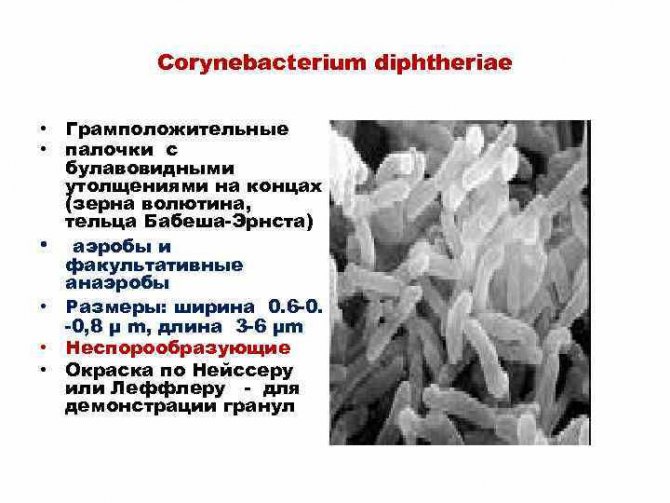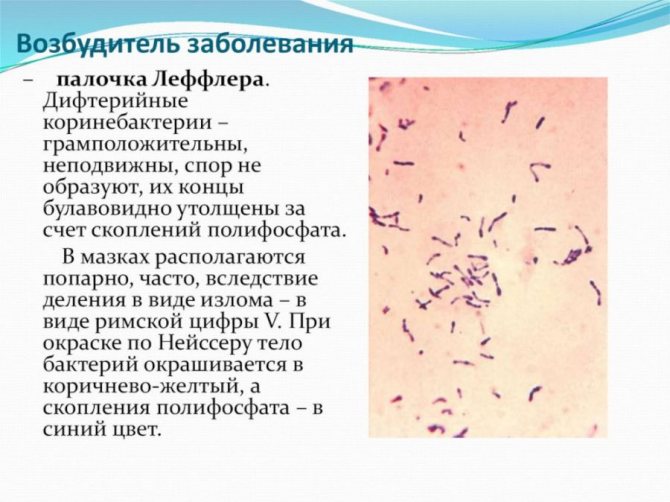The BL smear is a test for diphtheria, “BL” stands for “Leffler’s bacillus.” The disease is caused by corynebacteria, or diphtheria bacillus, which in most cases (more than 90%) affects the oropharynx, but can affect the larynx, bronchi, skin and other organs.
The main route of transmission is airborne, but infection through contact-household and oral-fecal (through food) methods is possible, especially in countries with hot climates.
The severity of the disease is due to an extremely dangerous toxin secreted by Loeffler's bacilli. Although sometimes there are non-aggressive forms, in particular, nasal diphtheria, which occurs without any complications.
Information: If the oropharynx is affected, croup may develop - narrowing of the lumen of the larynx due to the formation of a diphtheria film and swelling. This happens especially often in childhood.
When is it appointed?
Taking a smear for BL is indicated for people with characteristic symptoms that occur with diphtheria. They cannot always be distinguished, so the preliminary diagnosis is confirmed or refuted by laboratory tests.
The following signs may be a reason to undergo a smear test:
- a sharp rise in temperature to 38° or more;
- severe headache, weakness;
- rapid heartbeat - tachycardia;
- enlargement and hardening of regional lymph nodes, which respond with pain to pressure.
If diphtheria occurs in a mild form, then the condition improves after three days: the body temperature drops, the film in the throat becomes dirty white. A severe form of diphtheria is accompanied by fever, blue discoloration of the nasolabial triangle, and decreased blood pressure. With significant intoxication, hallucinations occur and dense swelling appears on the neck.
Diphtheria is included in the list of diseases against which people are vaccinated in childhood. This is a rather dangerous pathology that can cause severe complications if diagnosed and treated late. These include:
- attacks of suffocation;
- toxic shock;
- renal failure;
- damage to the nervous system and heart (myocarditis).
For prevention
BL smear analysis is also required in the following cases:
- when applying for a job in a child care facility, medical facility, or catering establishment;
- during pregnancy, to eliminate the risk of complications;
- if there was contact with a person sick with diphtheria.
Today, diphtheria is very rare, so timely diagnosis is of paramount importance
Help: Preventive measures are necessary to prevent the spread of the epidemic that can be caused by the diphtheria bacillus.
Diagnosis of diphtheria
Often, a clinical diagnosis of diphtheria is made without laboratory tests based on the presence of gray films on the mucous membrane of the throat. This can occur in small towns, with a mild course of the disease in relatively healthy adults. When examining children, people with chronic diseases, or when the clinical picture is unclear, laboratory testing is recommended.
The most commonly performed laboratory tests are:
- bacteriological smear analysis;
- serological analysis;
- PCR analysis;
- clinical blood test;
- antibody test.
Diphtheria croup is diagnosed by examining the larynx through a laryngoscope. The development of neurological pathologies requires the supervision of a neurologist. If there are signs of diphtheria myocarditis, a cardiologist will perform an ultrasound of the heart and an ECG.
Brief description of laboratory tests for diphtheria
Bacteriological analysis
The smear is fundamental for making a diagnosis. For research, biomaterial is taken and placed in a nutrient medium. It remains in the laboratory for 5–7 days, during which time it is possible to detect not only the development of the diphtheria bacillus, but also the presence of its toxigenic properties. If a toxigenic strain is identified, it is necessary to examine all those in contact with the patient.
, PCR diagnostics can be performed
. It is not required for diagnosis. The material is collected according to a similar scheme. PCR allows you to identify the pathogen and determine whether it is toxic.
Antibody tests
(RPGA or ELISA) are used to make a diagnosis. They take less time than bacteriological smear analysis, from 2 to 5 days. They allow you to assess the level of immunity (the degree of protection of the body from infection). Therefore, these tests are prescribed to people before employment in medical institutions and other structures that are at risk. Venous blood is required for the study.
Regardless of the diagnostic method of RPHA or ELISA, the test results are interpreted in the same way. The level marker is 1:10 or 0.01 IU/ml. If the value obtained is lower, then the chance of getting sick is high and vaccination is necessary.

Clinical blood test
is an auxiliary method, since it allows only to detect the presence of bacterial inflammation. The result cannot be used for differential diagnosis; it is impossible to distinguish diphtheria from tonsillitis. To perform CAO, venous blood is used.
Once the pathogen is identified or if diphtheria is suspected, the clinician must notify health authorities within 24 hours. This is necessary to organize the administration of a dose of antitoxic diphtheria serum (APDS) to an infected person, as well as to conduct an epidemiological investigation and identify the circle of contact persons. The health service is given 48 hours for this event.
Algorithm for taking a throat swab
An important condition is strict adherence to the correct technique. During the procedure, you should not touch the epithelium of the throat and tongue with the instrument, since they contain Hoffmann's pseudodiphtheria bacilli.
They are very similar to real Loeffler's bacilli and have almost the same structure, but are not pathogens. If there are pockets of filmy plaque in the oral cavity, a smear is taken along the edge.
The sampling algorithm is as follows:
Taking a smear for enterobiasis
- The patient is seated facing the light source.
- In his left hand, the physician takes a sterile spatula marked Z (throat) and a test tube.
- The patient opens his mouth, and the laboratory assistant presses with a spatula on the root of the tongue, immediately removing a sterile swab from the test tube by the stopper with his right hand.
- A smear is taken with this swab, which is passed along the arches of the oropharynx and palatine tonsils, without touching the mucous membranes on the sides.
- The swab is removed and placed in a test tube, the test tube is placed in a stand, and the spatula is disinfected.
For the procedure, wooden or metal knitting needles can also be used, on which cotton or gauze swabs are wound. Before taking a smear, the latter are moistened in 9% saline solution.
TAKING MATERIAL FOR BACILLUS LOEFFLER (BL)
Indications. Isolation of the pathogen from persons with suspected diphtheria to confirm the diagnosis and examination of contacts; examination of bacteria carriers after their sanitation, as well as patients with sore throats in the presence of plaque, stenotic laryngotracheitis, mononucleosis, peritonsillar abscess; examination of children newly admitted to orphanages, boarding schools, specialized institutions for children with central nervous system damage and tuberculosis; examination of children subject to surgical intervention for ENT pathology.
General information. A swab from the throat should be taken before taking antibiotics, other medications, rinsing the oropharynx with antiseptic solutions, and before brushing your teeth. The material is taken on an empty stomach or no earlier than 2 hours after a meal with immediate inoculation on a Petri dish with a nutrient medium. If this is not possible, immediately send the collected material to the laboratory. The seeding rate increases when taking material at the interface between the films and healthy tissue. When transporting over long distances, enrichment media or tampons moistened with a 5% solution of glycerin in an isotonic sodium chloride solution are used. Delivery to the laboratory should be made no later than 3 hours after taking the material.
Material support: 1) hermetically sealed sterile test tubes (2 pcs.) with cotton swabs on a wooden rod in a box or craft bags; 2) spatula in a craft bag;

Preparatory stage of performing the manipulation.
1. Wash and dry your hands, put on gloves.
2. Place the necessary equipment on the tool table.
3. Using a glass grapher, mark the number on the test tubes corresponding to the number in the direction. Place the test tubes in a rack.
4. Sit the child near the light source and invite him to open his mouth wide. Young children are secured by an assistant.
The main stage of the manipulation.
5. With your left hand, press the spatula onto the root of the tongue.
6. Use a tampon to remove mucus from the tonsils and arches at the border of the affected area and healthy mucous membrane, make sure that the tampon does not come into contact with the mucous membrane of the mouth and teeth.
7. Place the swab into the test tube without touching its outer wall.
8. Take a second tampon and insert it deep into the nasal passage.
9. Make several rotational movements.
10. Carefully remove the swab without touching the skin of the nose and place it in the second tube.
The final stage of the manipulation.
11.Wash and treat gloved hands with an antiseptic solution, remove gloves. Wash and dry your hands.
12. Complete a referral.
13.Transport the collected material in a container to the bacteriological laboratory.
Nasal swab collection technique
Before the procedure, the patient’s nose is cleared of mucus and crusts using cotton swabs or gauze, cotton flagella soaked in saline solution. This is done carefully so as not to injure the mucous membrane, since if blood gets into the sample, the results of the study will be distorted.
The biomaterial is taken according to the following algorithm:
- The patient sits with his head thrown back.
- The physician takes a sterile tube marked “N” (nose) in his left hand and removes a swab from it with his right hand.
- Having lifted the tip of the patient’s nose, the specialist inserts a tampon with his right hand, first into one nasal passage to a depth of 1.5-2 cm, then into the other.
After removing the swab from the nose, it is placed in a test tube, being careful not to touch its walls.
The essence of the study
In laboratory conditions, a sample is inoculated on nutrient media containing substances necessary for the active growth and cloning of diphtheria corynebacteria. Containers with the substrate and the sample taken from the patient are placed in a special thermostat. During the day, certain conditions are maintained in it - humidity, temperature and pressure.

Most corynebacteria are not pathogenic to humans, corynebacterium diphthtriae is one of the few exceptions
After 24 hours, the biomaterial is removed from the thermostat and studied. The presence of Loeffler's bacilli will be manifested by the growth of their colonies. Then a bacterioscopic analysis is performed, and some of the bacilli from the grown colonies are transferred to a glass slide.
Microorganisms are stained with special dyes and examined under a microscope. Diphtheria bacilli look like long pieces, thickened on one side. They are immobile and do not form spores.
Reference: Spores are a particularly persistent form of life of some microorganisms in which they can remain active for a long time even under unfavorable conditions.
If corynebacteria are detected, the laboratory gives a positive answer that the causative agent of diphtheria has been found. Next, several cultures are done on nutrient media to determine the type of pathogen and the degree of its toxicity - that is, the ability to synthesize toxins.
The study takes some time, so the results are given to the patient only after 2-4 days.
Decoding
If there is no diphtheria bacillus, “no growth” will be written in the “reference values” column. That is, normally there should not be Loeffler’s bacilli in the smear.
If a pathogenic microorganism is identified, the preliminary diagnosis of diphtheria or, if there are no symptoms, bacterial carriage is confirmed.

Loeffler's bacilli are recognized by their shape, location and characteristic yellowish and blue coloration
After determining the type of pathogen, an antibiotic sensitivity test is performed. Based on the data obtained, the most effective drug is prescribed, to which Leffler’s bacilli are least resistant.
Standard treatment regimens
Antibiotics are required for adult women and men. Most often these are the means listed in the following table:
| Name | How to take it |
| Erythromycin | Orally, 250-500 mg every 6 hours. For bacteria carriers – 250 mg every 12 hours. The duration of treatment is determined by the attending physician taking into account laboratory data |
| Ceftriaxone | Intramuscular injections in a dosage of 0.5-2 g 1-2 times a day. Max daily dose – 4 g |
| Rifampicin | In tablets 450-600 mg 1-2 times a day |
Tips on how to avoid getting infected with diphtheria
Tip #1
Since the disease is transmitted through communication between people, through objects and personal belongings, careful hygiene is extremely important. You should stay less in crowded places, do not use other people’s cutlery, and wash your hands more often. In addition, you need to fight the habit of touching your nose or mouth with dirty hands.
But hygiene alone does not save you from infection, hence the following advice.
Tip #2
The most reliable way to protect yourself from a dangerous infection is to get vaccinated. In our country, vaccination is carried out in children from an early age, and pediatricians must inform parents about this.
Complications
Diphtheria poses a serious danger due to its complications, both during the disease and after recovery. Most often, the course of the disease is complicated by toxic nephrosis (acute kidney damage), adrenal insufficiency, and infectious-toxic shock leading to coma. Inflammation of myocarditis and the trunks of the nervous system is common. Among the serious complications is paralysis of the respiratory tract, which can lead to asphyxia.
The most common cause of death is myocarditis, which usually occurs at the end of the first, beginning of the second week from the moment of infection. Damage to the nervous system can occur both during the period of illness and several months after recovery. Early and late peripheral paralysis are also observed. This leads to the following consequences: nasal voice, choking while eating, throwing it out through the nose, paralysis of the facial muscles, squint, ptosis, inability to distinguish small objects close up.
FAQ
Is it possible to get diphtheria again? Yes. People have a high natural susceptibility to the disease, but after an infection, antitoxic immunity is formed. However, it does not protect against bacterial carriage and re-infection, although it helps alleviate the course of the disease. In addition, complications occur much less frequently.
Newborns up to one year old are protected by specific antibodies to diphtheria toxin, which are transmitted from the mother to the fetus through the placenta.
How long does immunity last after vaccination? After vaccination, immunity lasts for 10 years. However, it is done for children at 3, 4.5, 6 months and repeated at 1.5 years, 6 and 14 years.
Causes
The source of the disease is an infected person: a patient or a carrier of a pathogenic strain. The pathogen is released from the body during the recovery period for quite a long time: from 15 days to 3 months. The route of transmission is aerosol, most often infection occurs by airborne droplets, less often by household contact or airborne dust. The stick can remain active on dishes and towels used by the patient. Able to multiply in food products: ready-made meals, meat, milk, cheese.

The bacterium is resistant to the external environment and remains viable for 2 months. It does not linger long on smooth surfaces; it can be found on soft toys, clothes, bedding, carpets, and wool products. The diphtheria bacillus tolerates cold, but dies at a temperature of +60 C within 10 minutes. Ultraviolet radiation (UV lamps and direct sunlight), disinfectants containing Lysol or chlorine are also harmful to it.
